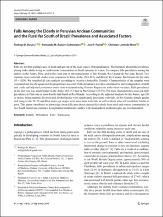Mostrar el registro sencillo del ítem
Falls among the elderly in Peruvian Andean Communities and the rural far South of Brazil: prevalence and associated factors
| dc.contributor.author | Meucci, Rodrigo D. | |
| dc.contributor.author | Runzer-Colmenares, Fernando M. | |
| dc.contributor.author | Parodi, José F. | |
| dc.contributor.author | Loret de Mola, Christian | |
| dc.date.accessioned | 2020-06-17T19:56:22Z | |
| dc.date.available | 2020-06-17T19:56:22Z | |
| dc.date.issued | 2020 | |
| dc.identifier.citation | Meucci RD., Runzer FM., Parodi JF., Loret C. Falls among the elderly in Peruvian Andean Communities and the rural far South of Brazil: prevalence and associated factors. J Community Health. 2020; 45: 363-369. | es_PE |
| dc.identifier.issn | 1573-3610 (Digital) | |
| dc.identifier.issn | 0094-5145 (Impreso) | |
| dc.identifier.uri | https://hdl.handle.net/20.500.12727/6227 | |
| dc.description.abstract | Falls are the fifth leading cause of death and are one of the main causes of hospitalization. The literature about falls prevalence among older adults living in rural/remote communities in South America is scarce. To compare falls prevalence among the elderly in the Andes, Peru, and in the rural area of the municipality of Rio Grande, Rio Grande do Sul state, Brazil. Two separate cross-sectional studies were conducted in Peru, Andes (N = 413), and Brazil, Rio Grande, Rio Grande do Sul state (N = 1029). We stratified all data analysis according to location (Andes/Rio Grande). Characteristics of the samples were compared and the chi square test for proportions was used. Falls prevalence was then calculated for each independent variable and crude and adjusted prevalence ratios were estimated using Poisson Regression with robust variance. Falls prevalence in the last year was much higher in the Andes (64.1%) than in Rio Grande (25.3%). For most characteristics assessed, falls prevalence in Peru was at least double that found in Rio Grande. According to the adjusted analysis for the Andes, age (80 or more), being married, divorced and alcohol intake were significantly associated with falls. In Rio Grande, female gender and being in the 70–79 and 80 or more age ranges were associated with falls as well as those who self-rated their health as poor. This paper contributes to knowledge about falls prevalence among the elderly from rural and remote communities in two South American countries. Longitudinal multicentre studies with standardized methodologies are recommended. | es_PE |
| dc.description.sponsorship | El proyecto de Río Grande recibió el apoyo del Consejo Nacional para el Desarrollo Científico y Tecnológico (CNPQ) a través de un investigación de becas de productividad, así como de la Coordinación para la Mejora del Personal de Nivel Superior (CAPES) / Ministerio de Educación y de Pastoral da Criança. Estudio de los Andes recibió apoyo de la Universidad San Martin de Porres. | es_PE |
| dc.format.extent | pp. 363-369 | es_PE |
| dc.language.iso | eng | es_PE |
| dc.publisher | Springer Nature | es_PE |
| dc.relation.ispartofseries | Journal of Community Health;vol. 45 | |
| dc.relation.uri | https://pubmed.ncbi.nlm.nih.gov/31559518/ | es_PE |
| dc.relation.uri | https://doi.org/10.1007/s10900-019-00751-5 | |
| dc.rights | info:eu-repo/semantics/openAccess | es_PE |
| dc.source | Repositorio Académico USMP | es_PE |
| dc.source | Universidad San Martín de Porres - USMP | es_PE |
| dc.subject | Anciano | es_PE |
| dc.subject | Prevalencia | es_PE |
| dc.subject | Accidentes por caídas | es_PE |
| dc.subject | Medio rural | es_PE |
| dc.title | Falls among the elderly in Peruvian Andean Communities and the rural far South of Brazil: prevalence and associated factors | es_PE |
| dc.type | info:eu-repo/semantics/article | es_PE |
| thesis.degree.name | Medicina Humana | |
| thesis.degree.grantor | Universidad de San Martín de Porres. Facultad de Medicina Humana | |
| thesis.degree.discipline | Medicina |
Ficheros en el ítem
Este ítem aparece en la(s) siguiente(s) colección(ones)
-
Artículos [274]







